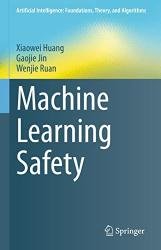Machine Learning Safety
- Добавил: literator
- Дата: 30-04-2023, 03:00
- Комментариев: 0
 Название: Machine Learning Safety
Название: Machine Learning SafetyАвтор: Xiaowei Huang, Gaojie Jin, Wenjie Ruan
Издательство: Springer
Серия: Artificial Intelligence: Foundations, Theory, and Algorithms
Год: 2023
Страниц: 319
Язык: английский
Формат: pdf (true), epub
Размер: 40.3 MB
Machine Learning algorithms allow computers to learn without being explicitly programmed. Their application is now spreading to highly sophisticated tasks across multiple domains, such as medical diagnostics or fully autonomous vehicles. While this development holds great potential, it also raises new safety concerns, as Machine Learning has many specificities that make its behaviour prediction and assessment very different from that for explicitly programmed software systems. This book addresses the main safety concerns with regard to Machine Learning, including its susceptibility to environmental noise and adversarial attacks. Such vulnerabilities have become a major roadblock to the deployment of Machine Learning in safety-critical applications. The book presents up-to-date techniques for adversarial attacks, which are used to assess the vulnerabilities of Machine Learning models; formal verification, which is used to determine if a trained Machine Learning model is free of vulnerabilities; and adversarial training, which is used to enhance the training process and reduce vulnerabilities.
This book addresses the safety and security perspective of Machine Learning, focusing on its vulnerability to environmental noise and various safety and security attacks. Machine learning has achieved human-level intelligence in long-standing tasks such as image classification, game playing, and natural language processing (NLP). However, like other complex software systems, it is not without any shortcomings, and a number of hidden issues have been identified in the past years. The vulnerability of machine learning has become a major roadblock to the deployment of Machine Learning in safety-critical applications.
We will first cover falsification techniques to identify the safety vulnerabilities on various Machine Learning models, and then devolve them into different solutions to evaluate, verify, and reduce the vulnerabilities. The falsification is mainly done through various attacks such as robustness attacks, data poisoning attacks, etc. Compared with the popularity of attacks, solutions are less mature, and we consider solutions that have been broadly discussed and recognised (such as formal verification, adversarial training, and privacy enhancement), together with several new directions (such as testing, safety assurance, and reliability assessment).
Specifically, this book includes four technical parts. Part I introduces basic concepts of Machine Learning, as well as the definitions of its safety and security issues. This is followed by the introduction of techniques to identify the safety and security issues in Machine Learning models (including both transitional Machine Learning models and Deep Learning models) in Part II. Then, we present in Part III two categories of safety solutions that can verify (i.e. determine with provable guarantees) the robustness of Deep Learning and that can enhance the robustness, generalisation, and privacy of Deep Learning. In Part IV, we discuss several extended safety solutions that consider either other Machine Learning models or other safety assurance techniques. We also include technical appendices.
The book aims to improve the awareness of the readers, who are future developers of Machine Learning models, on the potential safety and security issues of Machine Learning models. More importantly, it includes up-to-date content regarding the safety solutions for dealing with safety and security issues. While these solution techniques are not sufficiently mature by now, we are expecting that they can be further developed, or can inspire new ideas and solutions, towards the ultimate goal of making Machine Learning safe. We hope this book can pave the way for the readers to become researchers and leaders in this new area of Machine Learning safety, and the readers will not only learn technical knowledge but also gain hands-on practical skills. Some source codes and teaching materials are made available at GitHub.
Contents:
Скачать Machine Learning Safety
Внимание
Уважаемый посетитель, Вы зашли на сайт как незарегистрированный пользователь.
Мы рекомендуем Вам зарегистрироваться либо войти на сайт под своим именем.
Уважаемый посетитель, Вы зашли на сайт как незарегистрированный пользователь.
Мы рекомендуем Вам зарегистрироваться либо войти на сайт под своим именем.
Информация
Посетители, находящиеся в группе Гости, не могут оставлять комментарии к данной публикации.
Посетители, находящиеся в группе Гости, не могут оставлять комментарии к данной публикации.

